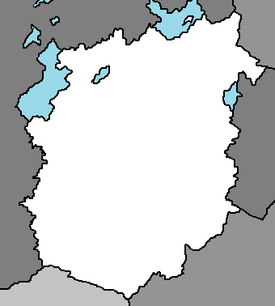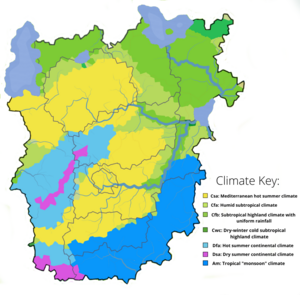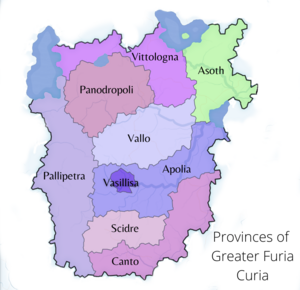Greater Furia Curia
Greater Furia Curia | |
|---|---|
 | |
| Capital | New Curia City |
| Official languages | English Iothic |
| Recognised national languages | Asothi Ixpash Oirumaric |
| Recognised regional languages | Mytikalian Ixpash Boren Iokish Subeski |
| Ethnic groups | 57% Iothic 21% Asothi 12% Ixpashi 6% Oirumaric 4% Other |
| Religion |
|
| Demonym(s) | Curian |
| Government | |
• Dynast Queen | Diantha Curie Ptochoprodroma |
• Megas Archon (traditional title); Premier (official title) | Zenovia Roussouli |
| Area | |
• | 1,700,000 km2 (660,000 sq mi) |
| Population | |
• 2020 census | 51,900,000 |
| Date format | mm-dd-yyyy |
Greater Furia Curia is a nation in the Coalition of Crown Albatross located on the continent of Adula. It is bordered by Somodi to the south, Timeria to the south and southeast, with Wareselt and Qalano to the east.
Etymology
History
Geography
Climate
In Greater Furia Curia, there is a noticeable variety of climates, with considerable differences between the areas, and also with some microclimates due to the different exposure of elevation, natural features, and air masses.
A large area of southeast Greater Furia Curia is covered by the Badamori Rainforest. The climate here is heavily affected by weather patterns from Timeria, making the climate almost equatorial, hot and humid throughout the year, with near-constant rainfall. The rains fall in the form of heavy showers and thunderstorms in the afternoon or evening. Total annual rainfall is considerable, from 2,000 to 3,000 millimeters (80 to 120 inches). The rains are more abundant from December to May, when they usually exceed 200 mm (8 in) per month, but they often even exceed 300 mm (12 in). Within the forest, the temperature remains below 30 °C (86 °F) even during the day, but relative humidity is consistently close to 100%. The cities built in the area, after removing a part of the forest, are a bit warmer because the sun's rays are obviously able to reach the ground.
In the mountainous areas of the southwest, in particular the Mytikalian Mountains in the southwest and the Bore Acropolite Mountains in the west, both exceeding 2,500 meters (8,200 feet), the climate is naturally colder, with heavy snowfalls in winter and afternoon thunderstorms in summer. Temperatures of -30°C to -40°C (-22 to -40 Fahrenheit) can occur in the mountainous areas in the east, and snow may lie on the ground 120 days of the year. Precipitation in these areas is not abundant in the valleys, where it amounts to about 500 millimeters (20 inches) per year, while it becomes a bit more abundant with increasing altitude.
In central-southern Greater Furia Curia where the two southern air masses meet, the climate is Albarinean, with mild, fairly rainy winters and hot and sunny summers. However, the central areas (see Eftychiamos) are still quite exposed to cold waves, so they can sometimes experience cold periods, and even snowfall. The amount of sunshine in Eftychiamos is great in summer, when clear skies prevail, while it's not so high from November to February, although there may be sunny days even in midwinter.
In western Greater Furia Curia (see Phegium), winter is even milder, and cold spells are less intense, even though there may be windy and somewhat cold days. Summer is hot and sunny, and the temperature and humidity frequently increase when hot air masses arrive from Timeria. The climate can be defined as almost oceanic: the rains are abundant in all seasons, so that even more than 2,000 mm (80 in) of rain fall per year. However, the summer rains are not continuous, but they are concentrated in periods of bad weather which last a few days.
In the northwestern region, winter is mild, with an average in January around 9 °C (48 °F); cold waves may still occur, but they are shorter and rarer than in the area of Eftychiamos. There are on average only 14 days with snowfall per year. Summer is sunny and hot: the maximum temperatures are around 30 °C (86 °F) along the coast, and they rise to 34/35 °C (93/95 °F) towards the interior, where cities like Sonti are found. High-temperature records are around 40 °C (104 °F). Summer, however, is usually tempered by the breeze along the coast of the Ulpian Mountains, though at times the breeze is replaced by a strong and persistent wind from Lake Cura Nova.
The northeastern region containing the Ulpian Mountains has a continental climate, with cold, snowy winters and hot, dry summers, though nights remain usually cool. Winds from the north can bring cold waves with heavy snowfalls and intense frosts. Lake Cura Nova, though very cold in winter, becomes warm enough for swimming in July and August.
Biodiversity
Demographics
Religion
Language
Provinces/States
Politics
Embassies
Government
The politics of Greater Furia Curia take place within the framework of a parliamentary representative democracy, a constitutional monarchy and a decentralised unitary state in which the monarch of Greater Furia Curia, Queen Diantha Curie Ptochoprodroma, is the head of state.







